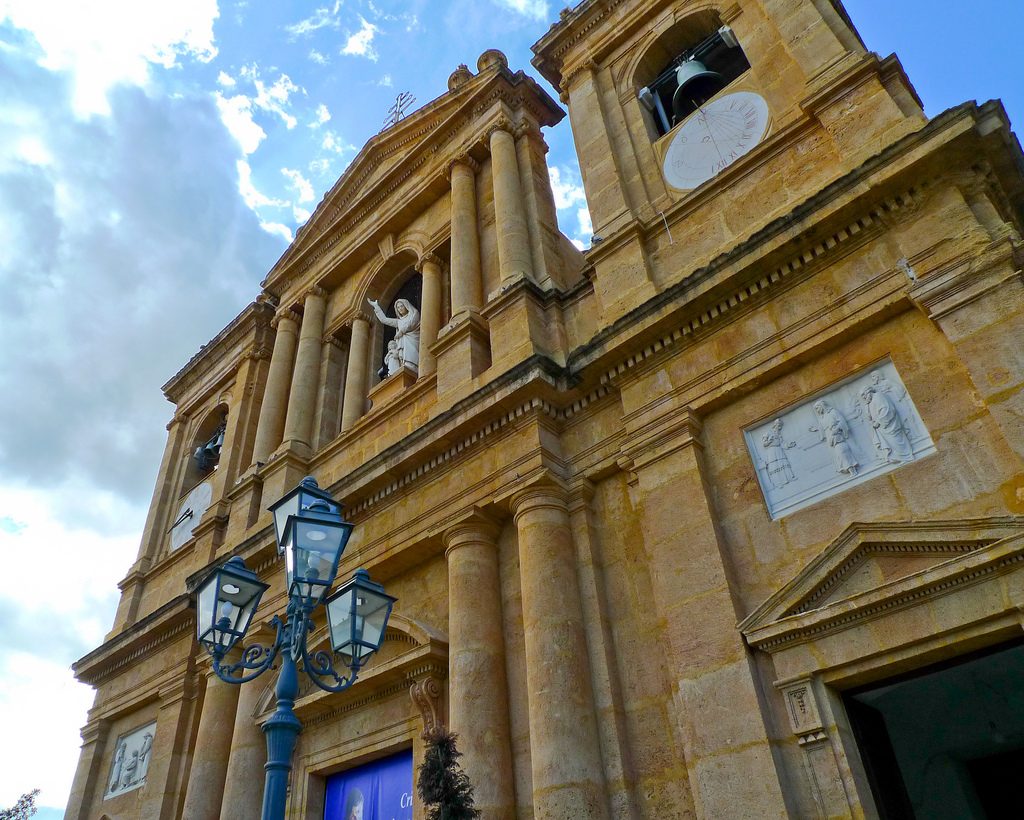The Basilica Soluntina di Sant’Anna (in Latin Soluntinæ Ecclesiæ), is located in the municipality of Santa Flavia in the province of Palermo. It is the mother church of the territory of Santa Flavia and parish seat.

Basilica Soluntina di Sant’Anna Santa Flavia
History
It was built on a pre-existing rural chapel of the early seventeenth century, perhaps already dedicated to St. Anne.
In 1666, purchased by the princes Filangeri together with a nearby “casina” – later replaced by the Filangeri villa – it assumed the role of family chapel: the first enlargements began in 1704 and ended in 1756, with the consecration of 19 June 1763.
A second phase of enlargement began in the same year 1756 and ended in 1785: the transformation was radical, so as to make a second and definitive consecration necessary on 24 July, the feast of the owner Sant’Anna.
With the aggregation of the basilica of San Giovanni in Laterano in 1764, the church acquired the title of basilica with the privilege of granting indulgences to anyone who visited it. In 1794, Pope Pius VI donated the bones of the Roman martyr St. Agapeno to the basilica, relics still kept in the original gilded and painted wooden case, placed between the red marble columns of the high altar.
Architecture
At the beginning of the first phase of the works, the oval nave rises up with four niches with polychrome marble altars, inspired by the Roman Baroque; only later were added the two side aisles and the presbytery.
The bright octagonal coffered dome that covers the oval nave, with the oculus of the lantern – covered on the outside with copper plates – has a striking visual impact, surrounded by a fresco with angels holding up a drape with golden fringes. Frescoes from the same era are located above the arches of the drum, with the representation of the eight Beatitudes.
Through an articulated double spiral staircase that precedes the main altar, protected by an original wrought iron gate by Antonio Campanella, there is access to a cryptacircular with three altars alternating with four niches, frescoed on the vault with putti and heraldic – religious symbols . Its original function was to keep the treasure of St. Anne and the relics of saints and martyrs; from the central altar, a tunnel that develops along the longitudinal axis of the presbyteral area, ends in the floor of the apse through an iron grid: it lost its function of ventilating the environment, following the construction of the choir and of the semicircular apse in 1785.
The main façade, in tuff, built in 1771 on a project by Antonio Interguglielmi, Giovan Battista Cascione Vaccarini (Palermo, 1729 – ivi, 1795 circa) and the Count Giovanni Filangeri of Santa Flavia (Palermo,? – 1752), presents itself with three entrance portals, divided by Doric columns at the base and Ionic semicolumns on the upper floor, with a serliana in the center that houses the group of Sant’Anna with Mary child in white marble.
Complete the two bell towers aligned to the side entrances, with baroque cusps: the left one with a mechanical clock, the other with a solar sundial.
The elevations and the roofs have been subjected to careful restoration work, completed in July 2007.
Works of art
On one of the pillars of the oval nave, is the memorial monument dedicated to Prince Pietro II Filangeri, a medallion with a high-relief bust in white marble framed by vegetal decorations and dominated by the family crest, by Ignazio Francesco Marabitti (Palermo, 6 January 1719 – there, 9 January 1797) of about 1762.
The baldacchino is an excellent work of fine cabinet-making which overlooks the high altar, a small-scale reproduction and Corinthian columns of the famous canopy of San Pietro by Gian Lorenzo Bernini: made by Domenico Di Stefano and partially gilded by Antonio Pellegrino, was conceived by the architect Antonio Interguglielmi (Palermo, about 1724 – there, 1822).
The high altar is surmounted by a high circular dome, on the outside covered with polychrome tiles, whose plumes are frescoed with the Doctors of the Church of the West and the East. Much of the stucco decorations were made by Bartolomeo Sanseverino (active in Palermo from the mid-30s to the seventies of the eighteenth century), a student of Giacomo Serpotta: his other work is the angel stucco umbrella umbrella, which dominates the rococo pulpit in gilded and lacquered wood.
Alongside the main altar are two organs with identical pediments, in carved, painted and partially gilded wood: the one on the left, restored only in the mechanical part in the nineties, dates back to 1791 and is the work of Giacomo Andronico in collaboration with the Messina Carlo Grimaldi .
In the four altars of the oval nave, there are the paintings on concave canvas by Carmelo Salpietra (Corleone, second half of the eighteenth century) representing: San Lorenzo with Saint George and saints martyrs (first altar on the left), San Michele Arcangelo (second altar) left), St. Peter’s with Saints Joseph and Anthony of Padua and Aaron (second altar on the right) and St. Teresa of Avila with Saints Agatha, Lucy, Clare and holy martyrs (first left altar).
The two altars of the side aisles are surmounted by two large blades, oils on centinate canvas, paintings of excellent workmanship in the second half of the eighteenth century from unknown, depict the Immaculate among the saints Rosalia and Francesco di Paola and San Benedetto in the presence of the Holy Trinity .
Of great value two polychrome wooden sculptures of almost real size: the risen Christ of about 1795, and the nineteenth-century Saint Joseph with baby Jesus, of the school of Antonio Bagnasco.
On the walls of the adjacent sacristy, from 1781, we can see some portraits of the Filangeri house, dating from the seventeenth to the eighteenth century.
